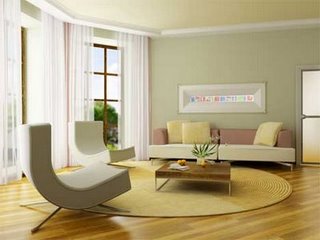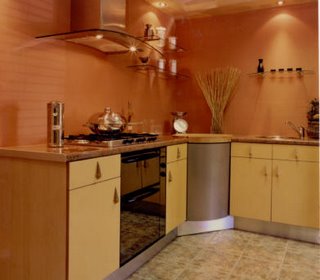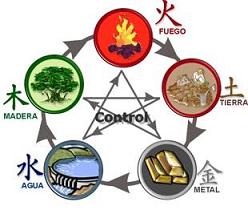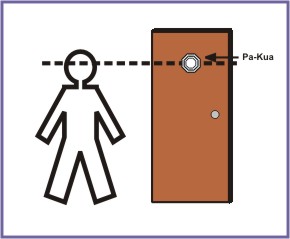Color is a big factor in decorating the rooms. Color gives a harmonious effect. If you use the right color, it will give your room the relaxing and comfortable atmosphere but if not, it will only lead to a disastrous and eerie feeling to the one who will use the room. Thus, make sure that color compliments well with all the parts of the room. Feng Shui, however, have a different principle about color. The color for Feng Shui has different meanings. Once you use the Feng Shui color principle, you can use your room more peacefully and you will have a more relaxing atmosphere. Now, in designing with color, here are the different Feng Shui tips that you can use in your bedroom, bathroom and the living area.
 Bedroom: Never use bright colors for bedroom. This is a common mistake by people. One example is red. You shouldn’t use red because it is a yang color while sleeping is yin. Thus, in choosing a color for your room, you should be using muted colors rather than the bright ones. You can also use elemental colors according to your natal chart. If you’re more of water, you can use a pale blue. You can also balance it out by using green which symbolizes wood.
Bedroom: Never use bright colors for bedroom. This is a common mistake by people. One example is red. You shouldn’t use red because it is a yang color while sleeping is yin. Thus, in choosing a color for your room, you should be using muted colors rather than the bright ones. You can also use elemental colors according to your natal chart. If you’re more of water, you can use a pale blue. You can also balance it out by using green which symbolizes wood.
Symbolizations for color in the natal chart are: red or pink (fire), orange, yellow or brown (earth), white, silver or gold (metal). For a kid’s bedroom, you can use yang colors for the wall while bright colors for the different accessories. This will let the child feel the resting as well as playing atmosphere inside his or her room.Bathroom: Think of the people who are going to use the bathroom. What are their elemental colors? The tip in choosing a bathroom color is that bathing is a yin color, so choose a yang color for the wall. Also, use earth colors on the toilet area so you can push the negative energy away.
[one_half_first]Living Areas: Remember to include the family in the color principle. Also, determine the different functionality of the room. If the living room is for relaxing, use the earth color. Party rooms won’t be much fun if you’re using yin colors and you can’t relax well if you’re using yang colors. Color harmony is a great secret that you can use in the different parts of your house.[/one_half_first][one_half_last][/one_half_last]
Positive Energy Symmetry throughout your Home: Feng Shui Interior Design
Feng Shui, pronounced as fung shway, is an ancient Chinese system that deals with aesthetics in correspondence to believed laws of Heaven (think of a night sky) and Earth, used to improve one’s life by through acquisition of positive ki. It is a system that is widely applied by the Chinese specifically in interior design. According to the feng shui system, there are several spots and positions on certain areas and establishments that can maximize the positive ki present in that area, and can indicate certain aspects and general ideas of the affected people’s fortune or destiny. Here are some general ideas of how feng shui based interior design works
 Information on feng shui interior design is still popularly applied by some people. It provides certain ideas and innovation that can also be used practically in designing homes. If you are interested in feng shui, you might want to hear some rules in the designing and decorating homes the feng shui way.
Information on feng shui interior design is still popularly applied by some people. It provides certain ideas and innovation that can also be used practically in designing homes. If you are interested in feng shui, you might want to hear some rules in the designing and decorating homes the feng shui way.
Finding the exact center of a building or structure is one way to start determining your home’s design based on feng shui. This is for you to easily and accurately apply them, because if you have chosen the wrong center for your feng shui based interior design, then all points that follow after it would end up in the wrong location, thus putting all your efforts into naught.
 Feng shui can be applied in a variety of ways that does not require any specific article to use. For instance, you can find the best bed position in your room using feng shui. According to feng shui, you should not place kid’s beds right across doors. The bed should ideally be at one side of the room and be able to see the door clearly. If possible, your kid’s bed should be placed at a corner, for a better sleeping experience.
Feng shui can be applied in a variety of ways that does not require any specific article to use. For instance, you can find the best bed position in your room using feng shui. According to feng shui, you should not place kid’s beds right across doors. The bed should ideally be at one side of the room and be able to see the door clearly. If possible, your kid’s bed should be placed at a corner, for a better sleeping experience.
Choosing the Right Colors to Bring Out the Chi
Feng Shui is an ancient Chinese method of seeking balance and harmony among things. In its literal meaning, Feng Shui means wind and water. The fundamental teaching of the Feng Shui is that the flow of vital energy known as the “qi” controls one’s prosperity, health and destiny.
 Moreover, Feng Shui teaches another important factor which is the five elements that match up with a specific color. These elements are wood, water, earth, fire and metal. Wood is the element that symbolizes the beginning of life and is represented by the color green. Water is the element that symbolizes giver of life and power and is represented by the colors black and blue. Earth is the element that symbolizes foundations of being and essential for good luck. This element is represented by the color brown. Fire is the element that symbolizes heat and is represented by the color red. Lastly, metal is the element that symbolizes joy and is represented by the colors white, silver and gold.
Moreover, Feng Shui teaches another important factor which is the five elements that match up with a specific color. These elements are wood, water, earth, fire and metal. Wood is the element that symbolizes the beginning of life and is represented by the color green. Water is the element that symbolizes giver of life and power and is represented by the colors black and blue. Earth is the element that symbolizes foundations of being and essential for good luck. This element is represented by the color brown. Fire is the element that symbolizes heat and is represented by the color red. Lastly, metal is the element that symbolizes joy and is represented by the colors white, silver and gold.
 Before one should decide on the Feng Shui color choice, one must first plot the structure of the room. According to the Feng Shui map, the “bagua” consists of nine (9) different zones that relate to nine major aspect of the human life: wealth and prosperity, fame and reputation, love and marriage, health, family, creativity and children, career, knowledge and self-cultivation and helpful people and travel.
Before one should decide on the Feng Shui color choice, one must first plot the structure of the room. According to the Feng Shui map, the “bagua” consists of nine (9) different zones that relate to nine major aspect of the human life: wealth and prosperity, fame and reputation, love and marriage, health, family, creativity and children, career, knowledge and self-cultivation and helpful people and travel.
One must first create his own bagua map by drawing a square and dividing the square into nine squares by drawing three rows of three. Once divided, the bottom should be colored blue, the bottom middle square black, and the bottom right square gray. The left middle square must be colored green, the center square yellow and the middle square white. On the top row of the squares, color the left square purple, the middle square red and the right square pink. Once all the squares have been colored, stand at the front entrance facing in. This position corresponds to the bottom row of the bagua map. If the house is a rectangle, then all the areas will be inside. If not, some of the areas of the house will be outside.
Zones associated with a particular color in Feng Shui
Each of these zones is associated with a particular color:
• Wealth and prosperity is associated with the color Purple. Purple also represents gratitude for all that you have. Having this appreciation will lead to physical, emotional and spiritual prosperity
• Fame and reputation is represented by the color Red. Red also represents the color of life and prosperity as well as integrity, virtue and authenticity.
• Love and marriage is represented by the color Pink. Pink likewise represents love for oneself.
• Family is represented by the color Green. Green also symbolizes peace and calmness as well as nurturing and balance as one grows and expands.
• Health is symbolized by the color yellow. Yellow also symbolizes warmth and cheerfulness.
• Creativity and Children is represented by the color white. White also represents purity, joy and openness.
• Knowledge and self-cultivation is represented by the color Blue. Likewise, blue represents trust and inner peace.
• Career is symbolized and represented by the color Black. This is also the color representing depth.
• Self empowerment and confidence is represented by the color Gray. Gray also helps create synchronicity in one’s life.
 As you analyze your bagua map, you will see the colors that surround your environment. These surroundings are manifestation of who you are as a person now and what would be your future endeavor. Remember that Feng Shui is about striking a balance and harmony rather than excess. Striking this balance will develop your deep satisfaction with stable results of the influence of your surroundings.
As you analyze your bagua map, you will see the colors that surround your environment. These surroundings are manifestation of who you are as a person now and what would be your future endeavor. Remember that Feng Shui is about striking a balance and harmony rather than excess. Striking this balance will develop your deep satisfaction with stable results of the influence of your surroundings.
The most basic principles of Feng Shui involve the five elements
Feng shui is an old Chinese art that in literal terms, would directly translate to “wind water”. It is an art that uses signs read from the earth around us including the sky and the sea to determine how best to balance the energies or “Qi” (pronounced “chi”) that is found all around us. It proposes several ideas about how to make your life obtain a more positive energy by simple methods; like arranging furniture in the most productive way. There are many different types and styles of feng shui, but all of them have the same goal; that is to direct more of the positive energies toward the person or place that you want.
The most basic principles of Feng Shui involve the five elements of wood, fire, earth, metal and water. Most of the other notions are based on the productive and the destructive cycles that these five elements go through. The productive cycle says that the element wood nourishes the element fire; which nourishes the element earth; which nourishes the element metal; which nourishes the element water; which in turn nourishes the element wood. The destructive cycle on the other hand determines that the element metal consumes the element wood; which consumes the element earth; which consumes the element water; which consumes the element fire; which in turn consumes the element metal.
These five elements form the foundation upon which most of the Feng Shui balance principles stand. They are very intrinsic in using Feng Shui to direct the energies and in creating the most desirable atmosphere for any location or individual.
Avoid Feng Shui blunders: learn the mistake that you’re making
Feng Shui principle, if properly practiced, could assure you of wealth and abundance in life, improved health conditions, enhanced self expression, life-long happiness and better relationships. Feng Shui is a century-old Chinese practice of putting things at its right place to help generate more positive energies and to eliminate the negative one. However, if improperly use it would bring you bad luck and misfortune. Oftentimes, people are too eager to see the result of Feng Shui happening in their life that more often than not they unconsciously violate some of the Feng Shui principles along the way. Here are some of the simple mistakes you’re probably making in Feng Shui.
1. Just too much of color red. In Feng Shui, Red is considered a very lively color and invites a lot of energy into an area. Many believed it is the luckiest color. However, the other side of it is that red emanates the fire element and is not necessarily the best way to stimulate a space. Fire element happens to strengthen earth specifically the earth-type energies that are causes of arguments, sickness, and accidents. So do not think that Red has it for your good fortune because it can also harm you if overuse.
2. Mirror here, mirror there and mirror everywhere. Mirrors are good deal for your bedroom. It symbolizes achievement and harmony. However, too many mirrors can create a distracted atmosphere to a room. You should not also place a mirror directly opposite to your bed as it can affect your sleeping patterns.
3. Feng Shui for what? Feng Shui basically functions in the area where the five elements existed and is therefore affecting every aspect of the people living in that certain space. So when using it, one should have a clear and specific goal of what he wanted to achieve. The flow of energy from the five elements will not be properly focused if the application of Feng Shui doesn’t have any specific goal.
4. Getting extremely fanatic of the principle. Remember that even a little movement or your things can produce a marvelous impact on the flow of energies. So you don’t to buy follow or buy everything suggested by a Feng Shui expert at once or else you will get impoverished. Rather, do it gradually.
 5. Feng Shui exclusively for me. If you are applying the principle of Feng Shui in your home it should not only cater to you alone but as well to the other members of the household. It cannot be that you alone will be happy while your husband or wife or other member of the family is uncomfortable.
5. Feng Shui exclusively for me. If you are applying the principle of Feng Shui in your home it should not only cater to you alone but as well to the other members of the household. It cannot be that you alone will be happy while your husband or wife or other member of the family is uncomfortable.
6. Not believing in personal feel. Many traditional Chinese objects such as ba gua mirrors may be used in Feng Shui but may not be appropriate as your home décor since you are not a Chinese. Other suggested colors that are not really appealing to you will not also work well. Feng Shui is basically flexible and can adjust according to your personal feel and taste.
7. Know only limited Feng Shui: Many of us only know very limited principles of Feng Shui. And from those, we follow them religiously and set aside the whole picture of the principle. In Feng Shui, it is important to know that everything are interconnected and the position or place of one thing to another is so important that they affect each other. For better guidance, it is still best to consult a Feng Shui consultants or experts who underwent intensive Feng Shui studies and training.

0 comments